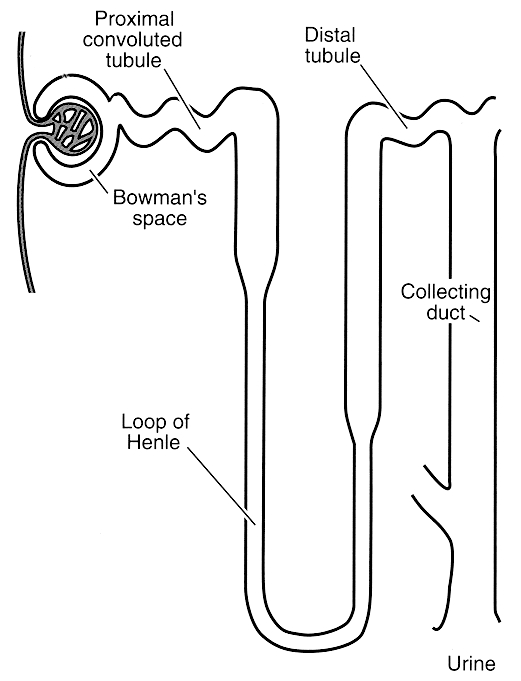
UFR = urine flow rate
this is equal to 1 for creatine , because creatinine is freely filtered and NOT reabsorbed or secreted by the kidneys
for water though :
Table 1 - Renal Function Chart
| Early Morning | Later Same Day | |
|---|---|---|
| UFR | ||
| GFR | ||
| Na Load | moles / min | moles / min |
| Na Excreted | moles / min | moles / min |
Indicate how glomerular filtration rate ( GFR ) changed during this day ( Table 1 )
Indicate how fractional excretion of water ( Table 1 ) changed during this day.
Indicate how fractional reabsorption of water ( Table 1 ) changed during this day.
Calculate filtered load for Na+ ( Table 1 ) during this day.
Calculate Na+ excretion rate ( Table 1 ) during this day.
Calculate fractional Na+ excretion ( Table 1 )
Calculate fractional Na+ reabsorption ( Table 1 )
Calculate osmolar clearance (
because each sodium ion is accompanied by anions ?
under normal conditions
Using the renal function data ( Table 1 ) , speculate on what likely occurred for this individual during this day.
Observation:
Significant Increase in UFR: From 0.7 mL / min to 15.1 mL / min.
Decrease in Urine Osmolarity: From 800 mOsm / L to 50 mOsm / L.
Decrease in Urine Na⁺ Concentration: From 196 mM to 9 mM.
GFR Remained Relatively Constant: Slight increase from 125 to 129 mL / min.
Speculation:
The individual likely consumed a large volume of water during the day , leading to:
Water Diuresis: Increased urine output to eliminate excess water.
Dilute Urine: Low urine osmolarity due to excretion of free water.
Conservation of Na⁺: Low fractional excretion of Na⁺ indicates the kidneys reabsorbed most Na⁺ to maintain electrolyte balance.
Answer:
The individual probably ingested a large amount of water, causing water diuresis characterized by high urine flow rate, dilute urine, and low urinary Na⁺ concentration, while maintaining stable GFR and efficient Na⁺ reabsorption.
Plasma protein concentration is ~40 g/L and glomerular filtrate contains 0.01 to 0.1 g/L , calculate the daily filtered load of plasma protein.
A healthy individual reports a plasma creatinine concentration of 100 µM and GFR of 120 mL / min. Assume that creatinine is freely filtered , not secreted , and not reabsorbed. Calculate the daily excretion rate for creatinine by the kidney. Determine the daily production rate for creatinine.
since creatinine is freely filtered and neither reabsorbed nor secreted , the excretion rate equals the filtered load
in steady state , the daily production equals daily excretion ,
therefore , daily production rate also equals 17.28 milli moles / day
In a patient with acute renal failure, GFR is reduced to almost zero. Determine how long it will take for the plasma concentration of an end-product of metabolism ( creatinine for example ) to be doubled.
with GFR near zero , creatinine is not being excreted. its being produced continuously
Volume of Distribution
Initial amount of creatine in the body
From Question 11 , the creatine production rate
Time
The healthy individual has one kidney removed for transplant to a close blood relative. Estimate their rate of creatinine excretion immediately after surgery. Estimate their excretion rate of creatinine after 24 hours. Comment on changes in their plasma creatinine concentration after surgery?
The plasma concentration of para-aminohippurate ( PAH ) was measured as 68 µM and urine PAH concentration was 31 mM , together with a urine flow rate of 1.2 mL/min. Calculate PAH clearance. Estimate renal plasma flow. Calculate the filtration fraction.
Using the filtration fraction, calculate the mean glomerular oncotic pressure if systemic oncotic pressure was 25 mmHg.
The proximal tubular osmotic gradient consists of luminal hypo-osmolarity ( 287 mOsM ) and interstitial hyper-osmolarity ( 293 mOsM ) , compared with intracellular osmolarity ( 290 mOsM ). Determine the osmotic gradient in mmHg between the lumen and cell, as well as between cell and peritubular interstitium.
The transport maximum for PAH is 0.4 mmole/min , and when plasma PAH concentration is increased to 1.2 mM , calculate the rate of PAH return to the systemic circulation.
After two hours of copious vomiting, a previously healthy individual is found to have a plasma pH of 7.55 , and a PaCO2 of 40mmHg.
Indicate the cause of the alkalosis.
Estimate the plasma bicarbonate concentration in the circumstance described.
Subsequent respiratory responses to this alkalosis bring plasma pH back down to 7.45 :
Indicate the respiratory response and its effect on PaCO2 and bicarbonate concentration.
Indicate the name for this response.
Indicate how acid-base balance and a normal PaCO2 and bicarbonate concentration are achieved over a longer period of time.